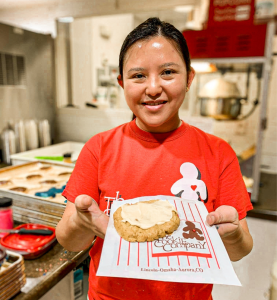Local & Independent restaurants are facing an uphill battle. It’s no secret that inflation is on the rise. This means that businesses of all types and sizes are feeling the pinch. For locally-owned and independent restaurants in Omaha, this can be especially tough. Franchises have more resources at their disposal, and they can often afford to keep prices low even in times of high inflation. How can mom-and-pop restaurants compete against these juggernauts? By leaning on their strengths!
In this article, we will discuss some of the strategies that these businesses can use to stay competitive during these challenging times. Thanks for reading!
Consumers Feeling The Pinch

Roni Fell is the co-owner of The Cookie Company
Feeling the budget crunch, diners have been going out to eat less frequently in recent months. Restaurant industry data has noted that monthly same-store restaurant traffic has shrunk compared with this time last year for the past eight months consecutively. In an effort to make up for lost business without turning away customers, both franchises and local and independent restaurants are working on cost-cutting measures.
Joseph Kenney, the founder of 316 Strategy Group, noted that restaurant chains have larger budgets, support from corporate, and access to sophisticated technology, but they can be slow to maneuver and bogged down by red tape and bureaucracy. Simple changes may never get approved.
According to Kenney, small, independent restaurants in Omaha have an advantage due to their size. These mom-and-pop establishments may not have large budgets or much cash on hand, but they can make changes more quickly. Small business owners like Roni and David Fell of The Cookie Company have learned to be agile and quickly pivot to the needs of their customer base. “It’s our superpower,” Roni jokes.
Franchises Have The Advantage
When it comes to inflation, small businesses are at a significant disadvantage compared to restaurant franchises like McDonald’s, Subway, Taco Bell, and Starbucks. Franchises can lock in prices early when buying ingredients from suppliers due to their massive size (and often receives more favorable contracts).
“Chain restaurants have the power to bargaining with suppliers,” Kenney said. “Local and independent restaurants like Javi’s Tacos in Omaha may have three locations but they don’t have a lot of room to leverage or switch suppliers.”
Chains that routinely negotiate restaurant goods and supplies can expect to save between 2-4% relative to their cost of goods sold.
Larger restaurant chains like Chipotle typically receive priority ordering from suppliers over local and independent restaurants.
 The Omaha Bakery is feeling the effects of ingredient shortages, with owner Michelle Kaiser saying she has to buy two or three times as much when they are available. This helps her avoid running out during the holiday season but puts more pressure on already slim profit margins.
The Omaha Bakery is feeling the effects of ingredient shortages, with owner Michelle Kaiser saying she has to buy two or three times as much when they are available. This helps her avoid running out during the holiday season but puts more pressure on already slim profit margins.
“Even with two bakeries in the Omaha metro area, I don’t have the buying power of a Cheesecake Factory, I don’t get to set my prices annually, and I’m just not going through enough product to matter to some of the bigger companies,” Kaiser said.
“In some cases, franchisors have stated they might offer short-term assistance to franchisees who are struggling to manage increased costs during periods of high inflation.” Kenney continued by saying this puts franchises at an advantage compared to local and independent restaurants.
On the other hand, independent operators such as Kris Copp–the owner of Copps Pizza and Copps Express in Omaha–said that he’s been encountering expenses much higher than average for things like labor, beef, cheese, eggs, napkins, and paper products.
“Costs really affect small restaurants like theirs because expenses have gone up lately, and not many people understand how tight budgets are for businesses right now,” he said.
Kaiser’s bakery recently added a cinnamon roll bar to help drive traffic to her bakery and improve the bottom line. Kaiser stressed the importance of being flexible during these challenging times.
Mom-And-Pops Can Be Flexible
Local and independent restaurants, like The Omaha Bakery, have the advantage of speed. If a mom-and-pop notice much higher prices for a key ingredient in an entree, they can quickly change prices, slim down the portion size, or even remove the item from their menu.
Flexibility is a major advantage that local and independents have over franchises. You can usually implement changes faster and are not bound by the same regulations that govern national chain restaurants.
Kenney also noted the importance of developing relationships with local suppliers and being able to work quickly with them in case of shortages or price increases.

Kris Copp, owner of Copps Pizza and Copps Express
For example, Copp said that if he needs to raise the price of one item, he likes adding a less expensive alternative to the menu.
“Yes, we have amazing burgers and steaks, but we also have some salads that are a little more affordable and chicken entrees that aren’t going to scare somebody away from coming in,” he said.
Kenney says that local and independent restaurants have more flexibility when it comes to changing prices or menu items. Customers frequenting fast-food chains expect the same prices at every location. Consumers care more about prices when they’re visiting a chain restaurant.
Out of 2,400 US consumers surveyed, over a third stated that price was a relevant factor when choosing between chain restaurants. On the contrary, only 22.5% said it played a role in their choice of local and independent eateries.
Local and independent businesses like Square Donut are beloved, in spite of national chains like Dunkin Donuts having brand recognition, pricing power, and constant financial support from their corporate headquarters.
“Franchises like Olive Garden are losing customers to Mangia Italiano and Virtuoso because of their amazing food and ‘local loving sentiment’ that is gaining momentum and being promoted by organizations such as Yocal, who help bring awareness to local and independently owned businesses,” Kenney said.
Consumers Have a Choice

The good news is that customers have a choice. Local and independent restaurants can and should take advantage of their strengths to compete against franchises during this era of inflationary times.
By developing relationships with local suppliers, being flexible with menu items, and offering affordable alternatives to expensive entrees, Mom-and-Pop restaurants can remain competitive and continue to attract customers for years to come but they need help.
Kenney said that people have a choice to make: they can go with large, everywhere chains or support local businesses. For example, instead of buying a holiday pie from Costco, they could buy one from Sweet Magnolias; order coffee from Starbucks or Karma Koffee; get a pizza from a national chain like Domino’s or Virtuoso Pizzeria in Benson. The benefits of supporting locally owned business owners like Javier Villa, owner of Javi’s Tacos, is that it keeps the money in the community and supports someone’s dream rather than an impersonal corporation.
According to consumer experts, 68 cents of every dollar spent at local and independent restaurants stays in that community. Experts say that’s more than four times the amount reinvested by big box chains.
Local and independent restaurants are the lifeblood of communities like Omaha and across America. Customers have a choice to make, and by leaning on their strengths, mom-and-pop eateries can stay competitive against franchises during inflationary times.










